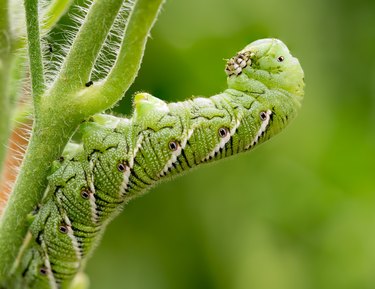
Small and almost unobtrusive, garden caterpillars don't look very dangerous. Some of them are even kind of pretty with their bright colors and bold patterns. Don't be fooled by this elaborate masquerade. Your plants know the entire sordid story — a gruesome tale of unspeakable carnage inflicted upon them.
Caterpillars, the larvae of moths and butterflies, damage your plants by chewing and feeding upon their tender leaves, shoots, flowers, fruit, and occasionally even some of the other parts. Don't panic — this isn't a catastrophe. You can easily take control and manage this situation without reaching for dangerous chemicals.
Video of the Day
Video of the Day
Doing Nothing Can Be Best
Sometimes, no action on your part is the best action. Try not to lose your mind over this, as finding a few caterpillars isn't the end of your garden as you know it. If only a very small number of caterpillars is present and damage is minimal, treatment isn't really necessary — just try to ignore it. If you have discovered the activity too late and the marauders are fully or nearly grown, they're pretty much done with feeding anyway, and treatment is essentially pointless.
Healthy, well-established adult plants are robust enough to shake off quite a bit of leaf damage as long as there aren't too many of the critters chewing on them for an extended period of time. Unhealthy, stressed, or young plants are not quite as tolerant of caterpillar abuse.
Plan of Action
Caterpillars have one job — eating — and nearly all of them are strict vegetarians. The only difference between "good" caterpillars and "bad" ones is up to you. Good caterpillars are the ones that grow into butterflies and moths you would like to keep around your property; bad caterpillars are all others. Take the time to learn to correctly identify the larvae of desirable moths and butterflies before simply destroying every caterpillar that appears in your garden.
When taking action is appropriate, handpicking, treating with nontoxic pest control products, and employing natural enemies of caterpillars are your best weapons. Overall, an integrated, nontoxic management approach is highly effective as well as safe for you, your pets, and the environment.
Monitoring Caterpillar Activity
The single most important aspect of fighting caterpillars is early detection, which prevents excessive damage. The key is vigilance and keeping a close eye on your plants. A case of caterpillars is easier to defeat while damage is still minor, the critters are still small, and before feeding activity becomes extensive.
Check everything daily. Be on the lookout for caterpillars, eggs, poop, and webbed or skeletonized leaves. Be very suspicious of any rolled leaves, which almost certainly house the beasties.
Manual Pest Control
Grab a bucket of soapy water and head for the battlefront. Put on some gardening gloves if you're the squeamish sort, but don't worry — caterpillars don't bite. Inspect each plant carefully and be sure to scrutinize the underside of leaves as well as petioles, where pests like to hide. Pinch or prune off any webbed or rolled leaves or stems, stuff the prunings into a plastic bag, and dispose of it in the garbage. Do not add the materials to your compost heap. When you find a caterpillar, pluck it from your plant. Squish it or just drop it into the bucket of soapy water, where it will drown.
Low-Impact Pesticides and Aggressive Predators
If tiny caterpillars appear despite your best manual control efforts, then you have strong evidence of breeding activity, for which you may need more aggressive (but still nontoxic) management techniques. Low-impact pesticides degrade quickly following application, producing minimal damage and little if any impact to bees, natural enemies, and pollinators:
Insecticidal soap must come into contact with the pest in order to be effective, so douse the caterpillars liberally with it. It works best when the pests are still young. Insecticidal soap has little or no adverse effects on beneficial insects.
Made from neem tree seed extract, neem oil is highly effective for killing a wide range of insect pests, including caterpillars. This material works best on critters that have not yet reached full growth. Neem oil must coat the caterpillar to kill it, but it is safe for beneficial insects and pollinators once it has dried.
Bacillus thuringiensis var. kurstaki (Btk) is a strain of Bt that hunts and kills only caterpillars. It's a bacterium that occurs naturally in soil. Coat the plant's foliage generously, as caterpillars have to ingest this material for it to kill them. Btk works best on young caterpillars and has no effect on other insects, including bees.
Spinosad is toxic to bees but is less risky to other beneficial insects, mammals, birds, and fish than most insecticides.
An effective weapon in the caterpillar assault, spinosad kills primarily by ingestion.
- Purchase parasitic wasps that specialize in parasitzing caterpillars (parasitics typically attack a specific host species), thereby minimizing the handpicking you'll have to do. These nonstinging insects typically lay their eggs inside host caterpillars. The eggs hatch and the larvae immediately begin eating the host. Attract naturally occurring parasitic wasps or keep your own home-growns hanging around by planting allium, zinnia, alyssum, yarrow, statice, cosmos, thyme, dill, lemon balm, and fennel.
- Attract natural predators of caterpillars to your property, including birds and spiders. Like parasitic wasps, these will help to reduce the amount of handpicking needed. You can also purchase green lacewing eggs to release into your garden.
Tip
Tactics for minimizing threats to bees and other pollinators include pruning flowers off treated plants so the beneficials won't be attracted to those plants. Because bees and pollinators only forage during daylight, limit your treatments to early morning or nighttime hours to significantly reduce the risks to them.